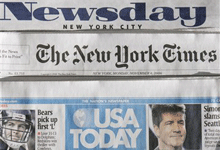The Wall Street Journal Europe’s dealings with a Dutch consulting firm to prop up circulation, exposed this week and resulting in the departure of its publisher, raises an obvious question: How much of this sort of thing goes on at financially-pressed U.S. newspapers?
I don’t know of any U.S. title that, like the Journal’s European edition, has promised, by contract, news coverage as part of a deal with a business partner. Nor have I known of a paper that maintains more than 80 percent of its circulation total with freebies, as the Wall Street Journal Europe has been doing.
But not all the paid circulation that newspapers count is actually purchased by end-users who subscribe or buy a single copy. I pulled the most recent Audit Bureau of Circulations reports for the three national newspapers (and the Journal’s Europe edition) to see how extensive these special circulation deals are.
Hotel circulation accounts for majority of USA Today figures
USA Today, as is hardly a secret, has long distributed a good share to its circulation to travelers in hotels. Its report for the six-month period ending March 2011 shows 973,000 of an average daily circulation of 1,829,000 comes from the hotel programs — about 53 percent.
USA Today has relied on hotel copies since its launch in 1982, but the deals have morphed over time. Slightly fewer than half are still placed outside guests’ room with a charge added to the bill (unless the guest declines).
The rest are simply left out in the lobby, breakfast rooms and hallways for the taking. Under the newest ABC rules, USA Today can charge as little as a penny per paper — so it could offer a hotel stack of 100 copies for a dollar a day.
Also, returns (copies not picked up) are not counted as they are by newsstands, so those remaining untouched at the end of the day in a hotel still count toward the total.
In addition, USA Today distributes 122,000 copies daily to schools, universities and businesses. So slightly less than 40 percent of its circulation comes from individually paid subscriptions or single copy sales.
The U.S edition of the Wall Street Journal has been ramping up its own hotel distribution, but it is a much smaller program than USA Today’s. The Journal’s latest circulation report shows an average of 107,000 out of 2.1 million in hotels and another 45,000 for businesses to give to designated employees.
With its long-established paywall, just over 500,000 of its 2.1 million circulation is digital, giving them the advantage in total circulation over USA Today.
The New York Times has an even more modest presence in hotels with 32,000 distributed to business travelers on an average weekday. The Times has long had aggressive promotion to university campuses, and the current report indicates 43,000 copies a day go to students.
(All these numbers could change in the six-month ABC reporting period that ended September 30, but that report is still being compiled for early November release.)
This free or discounted distribution all counts toward total circulation under ABC rules, as do deeply discounted introductory offers or carrying subscribers for a “grace period” after they have stopped paying.
Circulation controversy in the U.S.
But at least once in the last decade, the pressure to keep circulation numbers up led to fraudulent practices in the U.S. Between 2002 and 2004, the Dallas Morning News, Chicago Sun-Times, Newsday and Tribune Co.’s Spanish-language daily Hoy, all were found to be overstating circulation by tens of thousands of copies.
Each of the papers ended up compensating advertisers for the bogus circulation — typically with free advertising in future issues rather than rebates. The Tribune’s Newsday/Hoy scam resulted in criminal indictments and jail time.
The pattern of fraud — sometimes carried out by circulation employees, sometimes by independent distribution middle-men — seemed to reflect pressure from top management to make target numbers.
Other papers, I was told at the time, tightened up circulation practices in the wake of the scandal.
Wall Street Journal Europe circulation fallout
Keeping up circulation appearances seems to have been at the heart of the Wall Street Journal Europe debacle. The publication claimed average circulation of 75,000 for the first six months of this year. However, the second page of its audit statement, for those who read that far, shows that only 14,000 was from fully paid subs or single-copy purchases. The rest was through third-party sales (at less than 5 percent cover price) or other free-to-the-reader methods.
Had the Dutch firm canceled the deal, as it threatened a year ago, that would have caused roughly a 15 percent drop. Hence came the assortment of maneuvers, including promises of coverage and channeling money through third parties, to keep the arrangement intact.
From the publication’s weak circulation profile, the Wall Street Journal Europe can be presumed to be operating at a loss. News Corp. financials do not break out separate results, for the European edition or a companion Asian edition, nor do they indicate revenues or profitability for the Wall Street Journal and the rest of Dow Jones.
It is left to advertisers and their agencies to decide how valuable different segments of circulation are in reaching target customers. But this debacle is fresh evidence, to paraphrase George Orwell, that some circulation copies sold are more equal than others.







